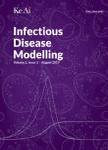Probabilistic modeling for an integrated temporary acquired immunity with norovirus epidemiological data
作者机构:Department of MathematicsFaculty of Physical and Computational ScienceCollege of ScienceKwame Nkrumah University of Science and TechnologyKumasiGhana Laboratory of Integrated Statistical Applications(LISA)Faculty of Physical and Computational SciencesCollege of ScienceKwame Nkrumah University of Science and TechnologyKumasiGhana Regional Water and Environmental Sanitation Center-KumasiCollege of EngineeringKwame Nkrumah University of Science and TechnologyKumasiGhana Department of Theoretical and Applied BiologyFaculty of Bio ScienceCollege of ScienceKwame Nkrumah University of Science and TechnologyKumasiGhana Research Group of Genomic EpidemiologyNational Food InstituteTechnical University of DenmarkKgs LyngbyDenmark Food Safety and ZoonosesDepartment of Veterinary and Animal SciencesFaculty of Health and Medical SciencesUniversity of CopenhagenStigb€ojlen 41870 Frederiksberg CDenmark Office for Innovation and Sector ServicesAdministrationTechnical University of DenmarkAnker Engelunds Vej2800 Kgs LyngbyDenmark Environment and ToxicologyDHIHorsholmDenmark
出 版 物:《Infectious Disease Modelling》 (传染病建模(英文))
年 卷 期:2019年第4卷第1期
页 面:99-114页
学科分类:1204[管理学-公共管理] 1004[医学-公共卫生与预防医学(可授医学、理学学位)] 1002[医学-临床医学] 1001[医学-基础医学(可授医学、理学学位)] 100201[医学-内科学(含:心血管病、血液病、呼吸系病、消化系病、内分泌与代谢病、肾病、风湿病、传染病)] 0701[理学-数学] 10[医学]
基 金:This work was supported by DANIDA SaWaFo project with grant number 11-058DHI
主 题:Quantitative risk assessment Probabilistic modeling Immunity integrated modeling
摘 要:Integration of acquired immunity into microbial risk assessment for illness incidence is of no doubt essential for the study of susceptibility to *** this study,a probabilistic model was set up as dose response for infection and a mathematical derivation was carried out by integrating immunity to obtain probability of illness *** acquire immunity from epidemiology studies which includes six different Norovirus transmission scenarios such as symptomatic individuals infectious,pre-and post-symptomatic infectiousness(low and high),innate genetic resistance,genogroup 2 type 4 and those with no immune boosting by asymptomatic infection were *** results on illness inflation factor as a function of dose and exposure indicated that high frequency exposures had immense immunity build up even at high dose levels;hence minimized the probability of *** Norovirus transmission dynamics data,results showed,and immunity included models had a reduction of 2e6 logs of magnitude difference in disease burden for both population and individual probable illness ***,the magnitude order of illness for each dose response remained largely the same for all transmission scenarios;symptomatic infectiousness and no immune boosting after asymptomatic infectiousness also remained the same *** integration of epidemiological data on acquired immunity into the risk assessment,more realistic results were achieved signifying an overestimation of probable risk of illness when epidemiological immunity data are not *** finding supported the call for rigorous integration of temporary acquired immunity in dose-response in all microbial risk assessments.



